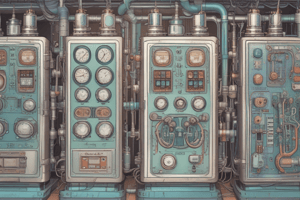Podcast
Questions and Answers
What is the primary function of an adjustable pressure limiting (APL) valve in a breathing system?
What is the primary function of an adjustable pressure limiting (APL) valve in a breathing system?
- To remove carbon dioxide from the patient.
- To deliver oxygen to the patient.
- To deliver inhaled anesthetic agents.
- To regulate the pressure within the breathing system. (correct)
Which of the following is NOT a common name for an adjustable pressure limiting (APL) valve?
Which of the following is NOT a common name for an adjustable pressure limiting (APL) valve?
- Spill valve
- Inspiration valve (correct)
- Expiratory valve
- Relief valve
What is the primary mechanism of action of an APL valve during spontaneous ventilation?
What is the primary mechanism of action of an APL valve during spontaneous ventilation?
- The valve opens due to positive pressure generated by the patient during expiration. (correct)
- The valve opens due to a controlled leak during inspiration.
- The valve remains closed during spontaneous ventilation.
- The valve opens due to negative pressure generated by the patient during expiration.
What is the minimum pressure required to activate an APL valve in the open position?
What is the minimum pressure required to activate an APL valve in the open position?
How does an APL valve function during positive pressure ventilation?
How does an APL valve function during positive pressure ventilation?
What is the primary function of a reservoir bag in a breathing system?
What is the primary function of a reservoir bag in a breathing system?
What is the most common material used to construct a reservoir bag?
What is the most common material used to construct a reservoir bag?
Which of the following Mapleson breathing systems is NOT commonly used during anesthesia?
Which of the following Mapleson breathing systems is NOT commonly used during anesthesia?
Which of the following is NOT a feature of an effective breathing system?
Which of the following is NOT a feature of an effective breathing system?
Why is it important that a breathing system has the ability to remove carbon dioxide from the patient?
Why is it important that a breathing system has the ability to remove carbon dioxide from the patient?
Flashcards
Breathing System
Breathing System
Device that conducts gases to and from the patient during anesthesia.
Main Features of Breathing Systems
Main Features of Breathing Systems
- Delivery of oxygen 2) Removal of carbon dioxide 3) Delivery of inhaled anesthetics.
Types of Breathing Systems
Types of Breathing Systems
Open, semi-open, semi-closed, and closed systems for gas management.
Mapleson Classification
Mapleson Classification
Signup and view all the flashcards
Adjustable Pressure Limiting (APL) Valve
Adjustable Pressure Limiting (APL) Valve
Signup and view all the flashcards
Mechanism of APL Valve
Mechanism of APL Valve
Signup and view all the flashcards
Reservoir Bag
Reservoir Bag
Signup and view all the flashcards
Function of Reservoir Bag
Function of Reservoir Bag
Signup and view all the flashcards
Positive Pressure Ventilation
Positive Pressure Ventilation
Signup and view all the flashcards
Spontaneous Ventilation
Spontaneous Ventilation
Signup and view all the flashcards
Study Notes
Breathing System Overview
- A breathing system delivers gases (oxygen and anesthetic agents) to the patient and removes waste gases (like CO2)
- Breathing systems must: deliver oxygen, remove carbon dioxide from the patient, and deliver inhaled anesthetic agents
Types of Breathing Systems
- Classified by Mapleson: Open, semi-open, semi-closed, closed
- Currently used systems include A, D, E, and F and their variations.
- Mapleson B and C are often used during recovery or emergencies.
Components of a Breathing System
-
Adjustable Pressure Limiting (APL) Valve: Allows exhaled gases and excess fresh gas flow (FGF) to escape, but prevents room air from entering
- Also known as expiratory valve, spill valve, or relief valve.
-
Reservoir Bag: Used in most breathing systems.
- Made of anti-static rubber or plastic (latex-free options exist)
- Standard adult size is 2L
- Smallest pediatric size is 0.5L
- Often ellipsoidal in shape
-
Tubing: Connects parts of the system and can act as a reservoir in some cases
- Typically plastic but other materials (silicone rubber, silver impregnated bactericidal plastics) are also used.
- Tubing width varies based on intended use (adults: 22mm, pediatric: 15mm)
- Corrugated tubing has higher flexibility but also greater turbulence compared to smooth-bore alternatives.
Mechanism of Action (APL Valve)
- One-way, adjustable, spring-loaded valve
- The spring adjusts the pressure required to open the valve
- The disc rests on a knife-edge, minimizing contact area
- Valve opens when the pressure in the breathing system exceeds the setting.
- During spontaneous ventilation, patient pressure opens the valve. (pressure less than 1 cm H2O)
- During positive pressure ventilation, a controlled leak is produced through the valve setting. This allows the control of the patient's airway pressure during inspiration.
Studying That Suits You
Use AI to generate personalized quizzes and flashcards to suit your learning preferences.




